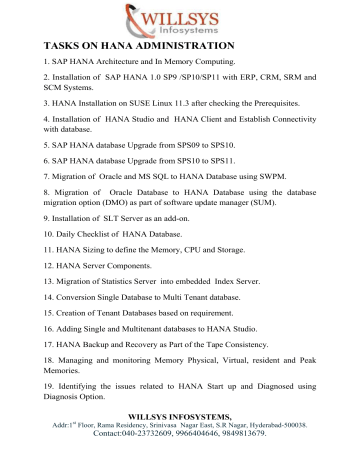
- #MANAGING SLT FROM SAP HANA STUDIO HOW TO#
- #MANAGING SLT FROM SAP HANA STUDIO INSTALL#
- #MANAGING SLT FROM SAP HANA STUDIO MANUAL#
- #MANAGING SLT FROM SAP HANA STUDIO CODE#
Part 1: Loading tables into the SAP HANA Database from ECC

Note that some steps may include multiple tasks you need to complete before continuing. We will outline this segment in the steps below. The next step in the SAP HANA SLT configuration process is to replicate source tables and copy them into the SAP HANA database.
#MANAGING SLT FROM SAP HANA STUDIO HOW TO#
How to Import SAP Source Data to SAP HANA with SLT More Resources for the SAP HANA Enthusiasts:īest Practices of SQL in the SAP HANA Database
#MANAGING SLT FROM SAP HANA STUDIO CODE#

#MANAGING SLT FROM SAP HANA STUDIO MANUAL#
SLT will create a DB connection for SAP HANA automatically when you configure a new transaction, so you won’t have to create a manual connection. Running SAP HANA SLT configuration protocols inside the Source eliminates the need for any RFC connections. Any non-SAP system will use the DB connection. The SAP Source connection is RFC, and the non-SAP connection is DB. SLT has two primary connections between SAP Source and any non-SAP systems. The replication server will create a log in the source whenever you replicate a table in the system.
#MANAGING SLT FROM SAP HANA STUDIO INSTALL#
However, you can also choose to install SLT as its own system You must install it as its own system if the source is non-SAP. If you are using SAP as your source system, you can install the SLT framework in the source itself. This server compiles all the metadata from various tables in the source system and transforms that data into a format that SAP HANA can read and use. The Landscape Transformation feature includes a data replication server. Architecture Between SLT and the Source System We will cover both of these relationships.

SLT also forms a connection between any non-SAP system and the HANA database.

The SAP HANA architecture within the SLT framework forms a connection between SLT and the SAP HANA system. Understanding some core features of SLT and its architecture may help you with the SAP HANA SLT configuration process. Our guide will take you through SLT’s architecture and provide instructions on the proper setup for SAP HANA SLT configuration. SLT allows you to schedule data replication tasks, move data during the replication process, and monitor various tables. SAP’s Landscape Transformation feature, or SLT, allows this real-time retrieval by loading the data to the HANA system from SAP and other sources. Its primary purpose is to store or retrieve data needed by applications in real-time. SAP HANA is an in-memory platform that serves as a relational database that application developers can use to find business solutions.


 0 kommentar(er)
0 kommentar(er)
